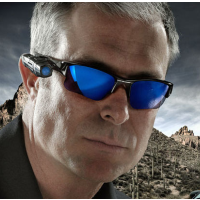Complaints and Use of Force Drop after Rialto Police Don Tiny Video Cameras
 (photo: NBC Southern California)
(photo: NBC Southern California)
The Southern California city of Rialto has become the poster child of police videotaping after being cited by a federal judge in his decision (pdf) two weeks ago striking down New York City’s stop-and-frisk law as an unconstitutional use of racial profiling.
U.S. District Judge Shira A. Scheindlin quoted a New York Times story attesting to the usefulness of body-worn cameras by police during an experimental period that began in February 2012 and ended last month.
“[T]he results from the first 12 months [were] striking. Even with only half of the 54 uniformed police officers wearing cameras on any given day, the department overall had an 88 percent decline in the number of complaints filed against officers, compared with the 12 months before the study.”
Perhaps not surprisingly, the study found that officers with cameras used force 60% less often.
Rialto Police Chief William Farrar, with the assistance of Barak Ariel, a visiting fellow at the Institute of Criminology at the University of Cambridge and an assistant professor at Hebrew University, randomly selected officers to place a small video camera on their lapels that recorded events, which were automatically uploaded to a computer for storage.
Police use of video cameras to observe the public has increased dramatically in recent years and drawn the attention of civil liberties advocates who aren’t fond of the authorities recording activities of people not suspected of wrongdoing and storing the data for indefinite periods of time.
Cameras are showing up on street corners and states are considering imbedding trackers in digital license plates. Police also use license plate scanners to profile drivers through storage of their GPS movement.
But recording the activities of police officers, while still raising questions about privacy and surveillance, is a different matter. Jay Stanley of the American Civil Liberties Union told the Times, “We don’t like the networks of police-run video cameras that are being set up in an increasing number of cities. We don’t think the government should be watching over the population en masse,” Stanley said. But “when it comes to the citizenry watching the government, we like that.”
Stanley, however, expressed reservations about the police videos being stored indefinately and popping up in public at inappropriate times, like on CNN.
Rialto is not the only city using the tiny police video cameras. Oakland, Albuquerque and Fort Worth use them too, according to the Times, as do others. Oakland has 450 cameras for its 660-member force and stores video indefinately.
Former Los Angeles Police Chief William Bratton is a fan and some experts think their widespread use is inevitable as the price comes down.
–Ken Broder
To Learn More:
In California, a Champion for Police Cameras (by Ian Lovett, New York Times)
Wearing a Badge, and a Video Camera (by Randall Stross, New York Times)
L.A. Police Crank up Surveillance Cameras to Spy on 450,000 Residents (by Ken Broder, AllGov California)
Floyd v. City of New York (U.S. District Court for Southern District of New York) (pdf)
Self-Awareness to Being Watched and Socially-Desirable Behavior: A Field Experiment on the Effect of Body-Worn Cameras on Police Use-of-Force (by Barak Ariel and William Farrar) (pdf)
- Top Stories
- Controversies
- Where is the Money Going?
- California and the Nation
- Appointments and Resignations
- Unusual News
- Latest News
- California Forbids U.S. Immigration Agents from Pretending to be Police
- California Lawmakers Urged to Strip “Self-Dealing” Tax Board of Its Duties
- Big Oil’s Grip on California
- Santa Cruz Police See Homeland Security Betrayal in Use of Gang Roundup as Cover for Immigration Raid
- Oil Companies Face Deadline to Stop Polluting California Groundwater





